 |
Editor’s note: This is one in a series of articles Mn/DOT Newsline
will publish looking back on the department’s first 25 years—remembering
the people, issues and cultural forces that have shaped the agency and the
milestones Mn/DOT has achieved. |
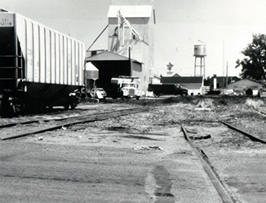 |
|
These dilapidated rails
on the route between Plainview and Eyota in Olmsted County in 1978 illustrate
the condition of the railroad before the Minnesota Rail Service Improvement
Program upgraded the track.
|
When Mn/DOT was formed in 1976, the state’s rail system was starting to unravel.
"The declining economics of the rail industry going back to the 1950s
led to major shakeups in the industry in the ‘70s and ‘80s—including rail abandonments,
bankruptcies and mergers," said Cecil Selness, Modal Operations Division
director.
That resulted in rail mileage in Minnesota dropping by half, from 9,400 to
4,700 miles. Moreover, many of the remaining rail lines were in poor condition.
Weakened roadbeds, loose ties, worn rails and other problems often limited
train speeds to 10 miles per hour. Shippers (such as grain elevator operators)
often complained about poor service, an inadequate number of cars, and long
waiting periods while engines moved loaded cars to market. A growing number
of abandoned lines offered some shippers little choice but to use trucks to
move grain and other commodities.
Trucking, however, can be more expensive. Shipping by rail instead of truck
could save farmers between 8 and 10 cents per bushel on their crops, as well
as reduce truck traffic on state highways.
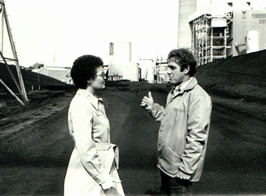 |
|
Listening to customers
was an important part of improving Minnesota’s rail system. Here, Donna
Rae McKenzie talks with the operator of a power generator about getting
railroad-shipped coal to his plant.
|
Recognizing the state’s rail crisis, the 1978 Minnesota Legislature created
the Minnesota Rail Service Improvement Program, said Al Vogel, director, Freight,
Railroads and Waterways.
The program authorized $25.5 million in bonds to railroads and shippers for
capital improvements (train engines and cars) and facilities (loading areas
and sidings, etc.).
The first rail improvement project upgraded tracks and equipment used to provide
service between Plainview and Eyota in southeastern Minnesota.
"We approved our first bond issue in 1982," Vogel said. "As
the loans are repaid, we can recycle the funds to assist other railroads to
stay viable." A total of $103 million has been allocated and repaid through
the program since it began, he said.
Vogel said that one short line carrier, the Lac Qui Parle Railroad that provides
service from Hanley Falls to Bellingham, was so successful after rehabilitation
that the line’s previous owner—the Santa Fe/ Burlington Northern Railroad—bought
it back.
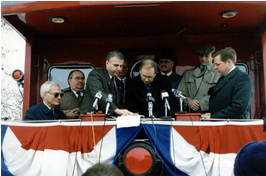 |
|
Former Mn/DOT Commissioner
Jim Denn shows former Gov. Arne Carlson where to sign an agreement allowing
the Dakota, Minnesota & Eastern Railroad to operate on tracks once
owned by the Union Pacific Railroad and the Chicago & North Western
Railroad companies. Photo by Kent Barnard
|
A larger regional carrier, the Dakota, Minnesota & Eastern Railroad, also
has prospered as a result of the program.
"The DM&E has paid back its loans and is now a strong, regional railroad
serving a large part of the state," Vogel said.
A total of 28 railroads now operate in Minnesota, according to Vogel. Four
of them are major carriers, including the Soo Line and SFBN; four are private
lines used in specialty activities such as logging operations. Twenty railroads
are the short and regional lines that support the state’s economic vitality
and growth.
"The rail improvement program increased use of rail by shippers,"
Vogel said. "Investments made by the railroad companies enable moving more
products a greater distance in a shorter period of time."
Mn/DOT also created a Rail Banking Program that set aside abandoned rail rights
of way to preserve their use for recreational trails and other public uses.
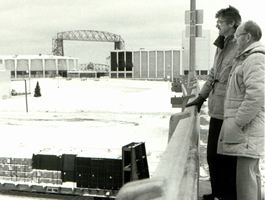 |
|
LeRoy Vague, a retired
OCFR employee, and Don Olson, a retired Duluth District employee, look
over the area in where five different railroads relocated their freight
yards in order for Mn/DOT to build I-35 through the city.
|
Since its inception in 1980, the program has preserved
318 miles of right of way for future use.
Another major Mn/DOT initiative has greatly improved safety at railroad crossings.
The Railroad Crossing Safety Improvement Program, which began in 1973, has significantly
reduced the number of crashes and injuries at rail crossings.
The safety program has combined pavement markings, improved signals and educational
campaigns such as Operation Life Saver to cut the number of crashes, injuries
and fatalities.
As a result, Minnesota reported a low of four deaths and 83 crashes at public
rail crossings in 2000, a sizeable decrease from
previous years. In 1998, by contrast, there were 105 crashes and nine people
died.
Rail passenger program begins
MnDOT’s rail program reached an important crossroad in 1992. That year, the
department became involved in planning a light rail transit line that would
have connected downtown Minneapolis and downtown St. Paul with the Hennepin
and Ramsey regional rail authorities.
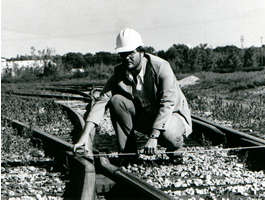 |
|
Railroad inspection
took a hands-on approach in 1981, as Kevin Nybloom measures
track width the old-fashioned way. Photo by Craig
Wilkins
|
That proposal failed, but in 1999 Mn/DOT signed agreements with the Hennepin
rail authority, the Metropolitan Council and the Federal Transit Administration
to build the Hiawatha light rail line. The line, currently in construction,
will connect downtown Minneapolis, the Minneapolis-St. Paul International Airport,
the Mall of America and other destinations. Mn/DOT leads the project’s design
and construction, and Metro Transit will operate the system when it is completed,
noted Mukhtar Thakur, director, Passenger Rail.
Mn/DOT’s other passenger rail initiatives include commuter rail projects such
as the Midwest Regional Rail Initiative and the Northstar Commuter Railroad.
The latter would connect St. Cloud with downtown Minneapolis.
The regional initiative would connect cities in nine states, using passenger
rail and feeder bus service that would supplement rail infrastructure to improve
passenger service. It would also replace long distance travel by car and airplane
with fast, safe, convenient rail service.
Intermodality holds key to successful future
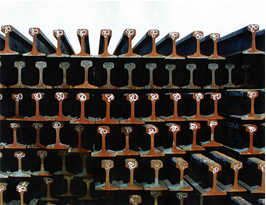 |
|
This stack of rails
waits to be put in place for the Hiawatha light rail transit line currently
under construction. Photo by Jurgen Sumann
|
Looking to the future, rail managers say expanded rail service linked to other
modes plays a major role in improving mobility for people and goods and ensuring
the vitality of the state’s economy.
They cite, for example, a commuter transferring easily from a commuter train
to a passenger flight, or a shipment of grain traveling by truck or rail to
a waiting river barge or Great Lakes freighter—all with minimal restrictions
or delays.
"The Twin Cities region is a major metropolitan area," said Commissioner
Elwyn Tinklenberg. "In order to keep it and the state vibrant, we must
make sufficient public investments in light rail, commuter rail and high-speed
and intercity rail, in addition to air and highways, in order to become truly
competitive."
Selness also sees intermodal transport for moving freight as crucial for the
state and the region’s to remain competitive in the global marketplace.
"Just as we need to maintain our roads and bridges," Selness said,
"we need to invest in ways to have rail, water and road transportation
modes work better together. Manufacturers, shippers and consumers are becoming
increasingly demanding for faster and cheaper transport. We need a larger share
of intermodal shipments to stay competitive in the world marketplace."
For more information, see Freight,
Railroads & Waterways; passenger
rail; and light
rail transit.
By Craig Wilkins
|
Mn/DOT memory. .
.
Few modes of transportation can evoke human emotions the way trains
can. They may bring back memories of trips to college or boot camp,
awake the forgotten joy of finding a toy electric train circling the
Christmas tree or stir longings for simpler times.
—Mn/DOT Express, October 1988
|
|


